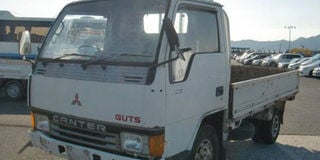Light trucks’ turf: Elf vs Canter

This Isuzu Elf, although it has been around for some time, it is still popular in Uganda, especially among dealers of construction materials.
Isuzu and Mitsubishi commercial trucks have been in production since the mid-20th century. They have a strong reputation for good quality and robust performance. The trucks range from the smaller 1.5 tonne to 30 tonne trucks and are built or designed to suit different commercial needs such as loading general cargo, dumping soil or rocks, water or fuel delivery, garbage or sewerage collection, frozen delivery of perishable foods or car recovery.
In Uganda, Isuzu and Mitsubishi trucks are sold as brand new trucks at their respective dealerships or as used trucks from the bonded warehouses. On the used Ugandan market the light commercial 1.5 tonne dumpers are very popular.
They come with engines ranging from the 2.8, 3.1, 3.6, 4.0 and 4.6 litre diesel engines. Today’s focus is on the 1994 model 2.8 litre diesel light dumper trucks Isuzu Elf also called N series and Mitsubishi Canter Guts also called the FE. The two rivalling trucks have been in production since 1958 and 1963 respectively.
Perfomance
The Isuzu Elf’s smaller 2.8 litre diesel power plant delivers the same engine power output at lower revolutions (revs) than the Mitsubishi Canter’s slightly bigger 2.8 litre diesel engine. This gives the Elf faster acceleration. However, the Canter delivers a higher engine torque at the same engine revs as the Elf. This gives the Canter superior towing or hauling power despite its poorer fuel economy when compared with the Elf.
Canter’s slightly bigger cargo bed dimensions allow it to carry a little more cargo volume than the Elf. The diesel engines of both trucks sound harsh, especially from outside the vehicle because the location of the engine under the cab does not allow adequate sound proofing. Gear shifting in the Canter requires double declutching because of its type of synchromesh and the reverse position of gear one is often confusing to first time users.
Handling
Both the Elf and Canter’s handling characteristics are the same. Road-holding and reluctance to roll on tight corners is excellent. Steering is light and precise thanks to the recirculating ball and nut power assisted steering systems. Their steering columns have two adjustments. Ride is excellent on smooth roads, with virtually no road noise. However both Elf and Canter’s suspension is uncomfortable on uneven roads.
Their semi elongated leaf springs with hydraulic shock absorbers have limited travel of about two inches on bump stops and bad or bumpy roads, especially when unladen. However, these trucks are purpose built for hauling heavy materials and not speeding around so the discomfort of driving them is negated by the benefit of their performance.
Styling, comfort and safety
Elf and Canter score evenly with exterior and interior styling. They have thoughtfully designed headlamps, side lamps and front grilles. The Canter side mirrors are rather bulky and not aerodynamic, but that is a small detail. The driver cabins carry three persons with reasonable though limited legroom.
Elf and Canter’s metres, gauge and warning lights display are clear and easy to understand. Comfort features on both trucks include driver and passenger head rests, cabin room lamps, cup holders, power windows and air conditioning are available as options ordered by the previous owners. Safety features on both the Elf and Canter include seatbelts for three passengers and an alluminium anti slip door step.
Reliability and resale value
The 1994 2.8 litre non turbo diesel engines on the Elf and Canter are easy to maintain because their filters are accessible with independent parts dealers downtown. The non-fast moving suspension, engine or body parts are also relatively easy to find both as new or used parts down town on Ben Kiwanuka Street and Kisekka market. The purchase price of both dumper trucks is steep but they have a good resale value.
Verdict
The Elf and Canter win four points for good handling, styling, comfort and safety standards and equally reliable maintenance parts supply as well as good resale value. The Canter wins narrowly with five points for better hauling and loading capacity.




